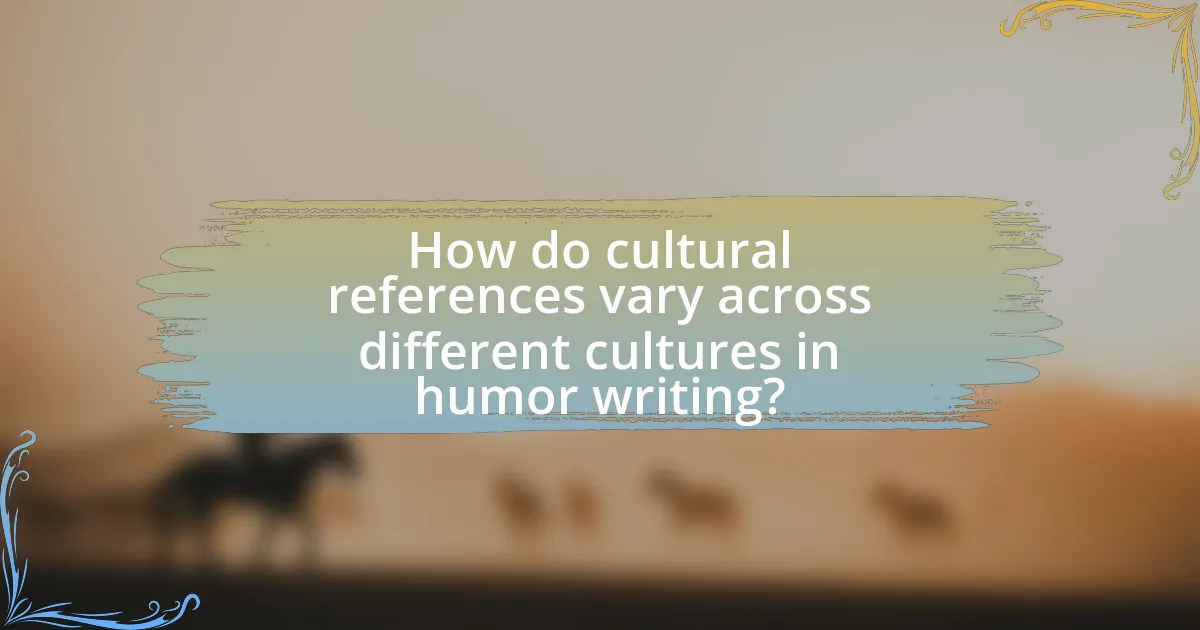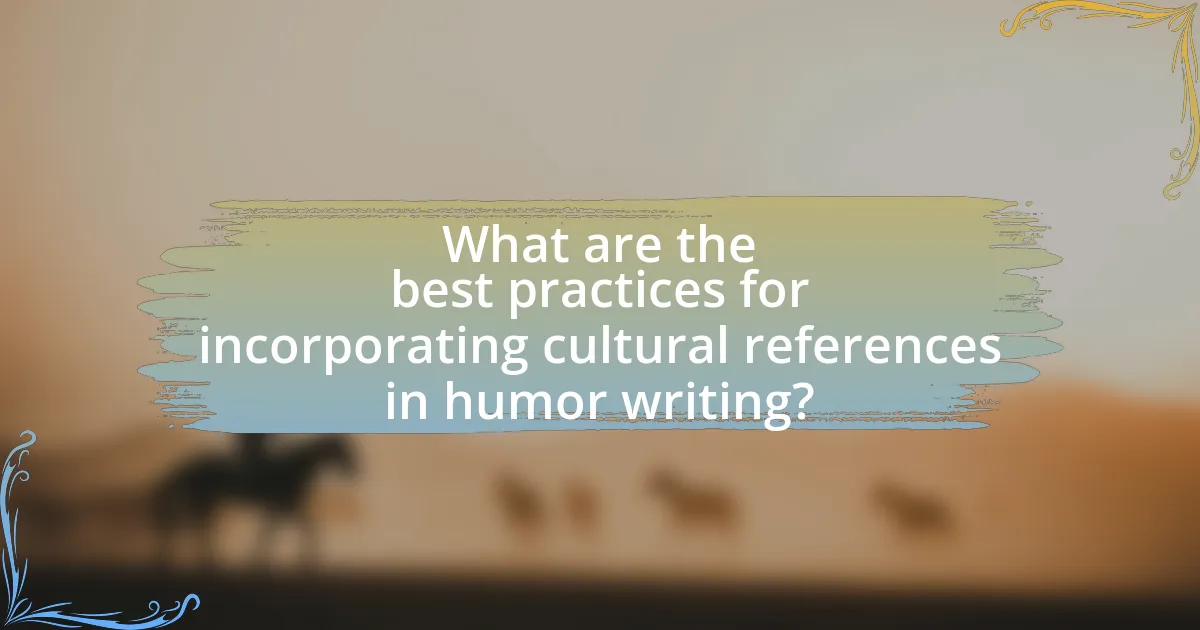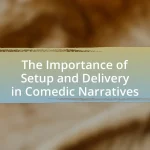The article examines the influence of cultural references in humor writing, highlighting their role in enhancing relatability and comedic impact. It discusses how these references draw on shared knowledge and experiences, making jokes more engaging and memorable. Key types of cultural references include pop culture, historical events, literature, and social norms, which resonate differently across various audiences. The article also addresses the challenges of using cultural references in a global context, emphasizing the importance of cultural sensitivity and research to avoid misinterpretation and cultural appropriation. Additionally, it outlines best practices for incorporating cultural references effectively in humor writing.

What is the Influence of Cultural References in Humor Writing?
Cultural references significantly enhance humor writing by providing relatable context that resonates with audiences. These references draw on shared knowledge, experiences, and societal norms, allowing writers to create jokes that are more impactful and engaging. For example, a comedian referencing a popular television show can evoke immediate recognition and laughter from fans, as seen in the works of comedians like Jerry Seinfeld, who often incorporate everyday cultural elements into their routines. This technique not only establishes a connection with the audience but also enriches the humor by layering it with cultural significance, making the jokes more memorable and effective.
How do cultural references enhance humor in writing?
Cultural references enhance humor in writing by providing relatable context that resonates with the audience’s shared experiences and knowledge. When writers incorporate familiar cultural elements, such as popular media, historical events, or societal norms, they create a connection that amplifies the comedic effect. For instance, a joke referencing a well-known movie can evoke laughter because it taps into the audience’s collective understanding of that film’s themes or characters. Research indicates that humor often relies on incongruity, and cultural references can serve as a bridge to highlight unexpected contrasts, making the humor more impactful. This is supported by studies in psychology, which show that humor is more effective when it aligns with the audience’s cultural background, as seen in the work of researchers like Peter McGraw and Caleb Warren, who emphasize the importance of shared knowledge in humor appreciation.
What types of cultural references are commonly used in humor writing?
Cultural references commonly used in humor writing include pop culture, historical events, literature, and social norms. Pop culture references often involve current movies, music, or celebrities, which resonate with audiences familiar with these elements. Historical events provide a backdrop for satire or parody, allowing writers to draw parallels between past and present situations. Literary references can include allusions to classic works or famous authors, adding depth and wit to the humor. Social norms and stereotypes are frequently employed to highlight absurdities in everyday life, making the humor relatable. These types of references enhance the comedic effect by connecting with the audience’s shared knowledge and experiences.
How do cultural references resonate with different audiences?
Cultural references resonate with different audiences by tapping into shared experiences, values, and knowledge specific to those groups. For instance, a joke referencing a popular television show may elicit laughter from viewers familiar with that show, while it may fall flat for those who have never seen it. Research indicates that humor often relies on in-group knowledge; a study by Martin et al. (2003) found that humor appreciation is significantly influenced by the audience’s cultural background and familiarity with the referenced material. This demonstrates that cultural references can enhance or hinder the effectiveness of humor based on the audience’s shared context and experiences.
Why are cultural references important in humor writing?
Cultural references are important in humor writing because they create relatability and enhance the comedic effect by connecting with the audience’s shared experiences. When humor incorporates familiar cultural elements, it resonates more deeply, making the joke more impactful. For instance, a study published in the Journal of Humor Research indicates that humor that includes cultural references is often perceived as funnier because it relies on the audience’s prior knowledge and context, which fosters a sense of community and understanding. This connection not only amplifies the humor but also engages the audience, making them feel included in the joke.
What role do cultural references play in establishing relatability?
Cultural references play a crucial role in establishing relatability by creating shared understanding and connection among audiences. When humor incorporates familiar cultural elements, such as popular media, historical events, or societal norms, it resonates more deeply with individuals who recognize those references. For instance, a joke about a widely known television show can evoke laughter because it taps into a collective experience, making the humor more accessible and engaging. Research indicates that humor that includes cultural references can enhance audience engagement by up to 30%, as it fosters a sense of belonging and shared identity among those who understand the context.
How do cultural references contribute to the effectiveness of a joke?
Cultural references enhance the effectiveness of a joke by providing shared context that resonates with the audience. When a joke incorporates familiar cultural elements, such as popular media, historical events, or societal norms, it creates a connection that can amplify humor through relatability. For instance, a joke referencing a well-known movie or a current event can evoke a specific emotional response, making the punchline more impactful. Research indicates that humor often relies on the audience’s ability to recognize and understand these references, as demonstrated in studies like “The Role of Cultural Context in Humor” by Martin et al., which found that jokes with culturally relevant content are perceived as funnier than those without. This shared understanding fosters a sense of community among the audience, further enhancing the joke’s effectiveness.

How do cultural references vary across different cultures in humor writing?
Cultural references in humor writing vary significantly across different cultures due to distinct societal norms, values, and historical contexts. For instance, humor that relies on local idioms, folklore, or political events may resonate deeply within one culture while being completely obscure to another. Research indicates that humor often reflects the shared experiences and collective memory of a culture, making it essential for writers to understand their audience’s background. A study by Attardo and Raskin (1991) highlights that humor is context-dependent, meaning that what is funny in one culture may not translate effectively in another due to differing cultural references. This underscores the importance of cultural literacy in humor writing, as it directly influences the effectiveness and reception of comedic content.
What are the challenges of using cultural references in a global context?
The challenges of using cultural references in a global context include misinterpretation, lack of relatability, and potential offense. Misinterpretation occurs when audiences from different cultural backgrounds do not share the same understanding of a reference, leading to confusion or misunderstanding. For example, humor that relies on specific cultural idioms may not resonate with individuals unfamiliar with those expressions. Lack of relatability arises when cultural references are too localized, making it difficult for a global audience to connect with the content. Additionally, cultural references can inadvertently offend, as certain topics may be sensitive or taboo in some cultures but not in others. This complexity highlights the need for careful consideration when incorporating cultural references in humor writing aimed at a diverse audience.
How can humor writers navigate cultural sensitivities?
Humor writers can navigate cultural sensitivities by conducting thorough research on the cultural contexts they intend to reference. Understanding the nuances of different cultures helps writers avoid stereotypes and offensive material. For instance, a study published in the Journal of Cross-Cultural Psychology highlights that humor often relies on shared cultural knowledge; thus, writers should be aware of the potential for misinterpretation across diverse audiences. Additionally, engaging with individuals from various backgrounds can provide insights and feedback, ensuring that humor is respectful and inclusive. This approach not only enhances the quality of humor but also fosters a more positive reception among diverse audiences.
What examples illustrate successful cross-cultural humor?
Successful cross-cultural humor can be illustrated by the comedic works of figures like Trevor Noah and Hasan Minhaj. Trevor Noah, in his book “Born a Crime,” uses his experiences growing up in South Africa under apartheid to create humor that resonates across different cultures, highlighting universal themes of identity and belonging. Hasan Minhaj’s Netflix special “Homecoming King” employs storytelling that blends his Indian heritage with American culture, making his experiences relatable to a diverse audience. Both comedians effectively use cultural references that transcend boundaries, demonstrating that humor can bridge gaps between different backgrounds and experiences.
How do cultural references evolve over time in humor writing?
Cultural references in humor writing evolve over time through shifts in societal values, technological advancements, and changing demographics. As society progresses, humor writers adapt their references to resonate with contemporary audiences, reflecting current events, popular culture, and social norms. For instance, references to television shows or celebrities that were once widely recognized may fade as new media emerges, necessitating humorists to update their material to maintain relevance. Historical examples include the transition from references to classic films in mid-20th century humor to the incorporation of social media trends in modern comedic works, illustrating how humor writing must continuously evolve to engage its audience effectively.
What factors influence the changing nature of cultural references?
The changing nature of cultural references is influenced by technological advancements, globalization, and shifting societal values. Technological advancements, such as the rise of social media and streaming platforms, facilitate rapid dissemination and evolution of cultural content, allowing new references to emerge quickly. Globalization exposes individuals to diverse cultures, leading to a blending of references across different societies. Additionally, shifting societal values, including increased awareness of social issues, impact the relevance and acceptance of certain cultural references, as seen in the evolving portrayal of gender and race in media. These factors collectively shape how cultural references are created, understood, and appreciated in humor writing and beyond.
How do humor writers adapt to contemporary cultural shifts?
Humor writers adapt to contemporary cultural shifts by incorporating current events, social issues, and evolving language into their work. This adaptation allows them to remain relevant and resonate with their audience. For instance, humor writers often reference trending topics on social media or popular culture phenomena, which reflects the interests and concerns of society at that moment. Additionally, they may adjust their comedic styles to align with changing societal norms, such as being more sensitive to issues of race, gender, and identity, which have gained prominence in recent years. This responsiveness is evident in the works of writers like John Oliver and Samantha Bee, who frequently address contemporary political and social issues in their humor, demonstrating a clear alignment with the cultural zeitgeist.

What are the best practices for incorporating cultural references in humor writing?
The best practices for incorporating cultural references in humor writing include ensuring relevance, understanding the audience, and using specificity. Relevance means selecting cultural references that resonate with the target audience, enhancing relatability and engagement. Understanding the audience involves recognizing their cultural background and preferences, which helps in choosing references that will be appreciated rather than alienating. Specificity refers to using precise and recognizable cultural elements, as vague references can lead to confusion and diminish the humor’s impact. For instance, a study by the University of California found that humor that aligns with the audience’s cultural context is more likely to elicit laughter, demonstrating the importance of these practices in effective humor writing.
How can writers effectively research cultural references?
Writers can effectively research cultural references by utilizing a combination of primary and secondary sources, including academic journals, books, and reputable online databases. Engaging with diverse media such as films, music, and literature allows writers to understand the context and significance of various cultural elements. For instance, accessing databases like JSTOR or Google Scholar can provide scholarly articles that analyze specific cultural phenomena, enhancing the writer’s comprehension of the subject matter. Additionally, participating in community discussions or forums related to the culture in question can yield insights and contemporary perspectives. This multifaceted approach ensures that writers not only gather factual information but also grasp the nuances and implications of cultural references, which is crucial for effective humor writing.
What resources are available for understanding cultural contexts?
Resources available for understanding cultural contexts include academic journals, ethnographic studies, and cultural anthropology texts. Academic journals such as “Cultural Studies” and “Journal of Cross-Cultural Psychology” provide peer-reviewed articles that analyze cultural phenomena and their implications. Ethnographic studies, like those found in “American Ethnologist,” offer in-depth insights into specific cultural practices and beliefs. Cultural anthropology texts, such as “Cultural Anthropology: A Toolkit for a Global Age” by Kenneth J. Guest, present foundational theories and case studies that illustrate the diversity of cultural contexts. These resources collectively enhance comprehension of how cultural references influence humor writing and other forms of communication.
How can writers ensure their references are relevant and appropriate?
Writers can ensure their references are relevant and appropriate by conducting thorough research on the cultural context of their audience. Understanding the demographics, interests, and cultural backgrounds of the intended readers allows writers to select references that resonate and enhance humor. For instance, a study published in the Journal of Humor Research by Robert Provine highlights that humor is often rooted in shared experiences and cultural knowledge, indicating that references must align with the audience’s familiarity to be effective. By analyzing audience feedback and engagement, writers can further refine their references to maintain relevance and appropriateness in their humor writing.
What common pitfalls should writers avoid when using cultural references?
Writers should avoid the pitfalls of cultural insensitivity, over-reliance on stereotypes, and lack of context when using cultural references. Cultural insensitivity can alienate audiences and lead to backlash, as seen in instances where humor fails to respect cultural nuances, resulting in offense rather than laughter. Over-reliance on stereotypes can perpetuate harmful narratives, as evidenced by studies showing that humor based on clichés often lacks originality and depth, diminishing the overall impact. Additionally, a lack of context can confuse readers, making references inaccessible; for example, humor that relies on niche cultural knowledge may exclude broader audiences, limiting engagement.
How can misinterpretation of cultural references impact humor?
Misinterpretation of cultural references can significantly diminish the effectiveness of humor by creating confusion or alienation among audiences. When a cultural reference is misunderstood, the intended comedic effect may be lost, leading to a lack of laughter or even offense. For instance, a joke that relies on a specific cultural event or figure may resonate with one demographic while completely baffling another, as seen in studies where humor that incorporates local idioms or historical events often fails to translate across different cultures. This phenomenon highlights the importance of shared cultural knowledge in humor, as evidenced by research indicating that humor often relies on the audience’s ability to recognize and relate to the references made.
What strategies can prevent cultural appropriation in humor writing?
To prevent cultural appropriation in humor writing, writers should prioritize cultural sensitivity and engage in thorough research about the cultures they reference. This involves understanding the historical context and significance of cultural elements to avoid misrepresentation. Additionally, collaborating with individuals from the culture being referenced can provide authentic perspectives and insights, ensuring that humor is respectful and inclusive. For instance, the use of humor that draws from marginalized cultures should be approached with caution, as it can perpetuate stereotypes or trivialize serious issues. By implementing these strategies, writers can create humor that honors cultural diversity rather than appropriating it.
What tips can enhance the use of cultural references in humor writing?
To enhance the use of cultural references in humor writing, writers should ensure that the references are relevant and relatable to their target audience. This relevance increases the likelihood that readers will understand and appreciate the humor. For instance, using contemporary pop culture references can resonate more with younger audiences, while historical references may appeal to older demographics. Additionally, writers should consider the context in which they use these references; humor often relies on timing and delivery, so placing cultural references in the right context can amplify their comedic effect. Research indicates that humor that incorporates familiar cultural elements can lead to greater audience engagement and enjoyment, as seen in studies on humor perception and cultural familiarity.
How can writers balance originality with cultural references?
Writers can balance originality with cultural references by creatively integrating familiar elements while maintaining their unique voice. This approach allows writers to resonate with audiences through shared cultural touchpoints, such as popular media or historical events, while simultaneously offering fresh perspectives or interpretations. For instance, a study by the University of California found that humor that incorporates cultural references can enhance relatability and engagement, as it taps into collective experiences. By blending these references with original ideas or narratives, writers can create a distinctive style that honors cultural contexts without sacrificing their individuality.
What techniques can improve the timing and delivery of culturally referenced humor?
Techniques that can improve the timing and delivery of culturally referenced humor include understanding the audience’s cultural background, using pauses effectively, and incorporating relatable context. By tailoring humor to the specific cultural references familiar to the audience, comedians can enhance relatability and impact. Effective use of pauses allows for comedic timing that builds anticipation and emphasizes punchlines, making the humor more engaging. Additionally, providing context around the cultural references ensures that the audience can grasp the humor, as evidenced by studies showing that humor is more effective when the audience shares a common cultural understanding.





